How to Get Rid of Pokeweed Effectively
This invasive plant keeps coming back, but the right treatments can help
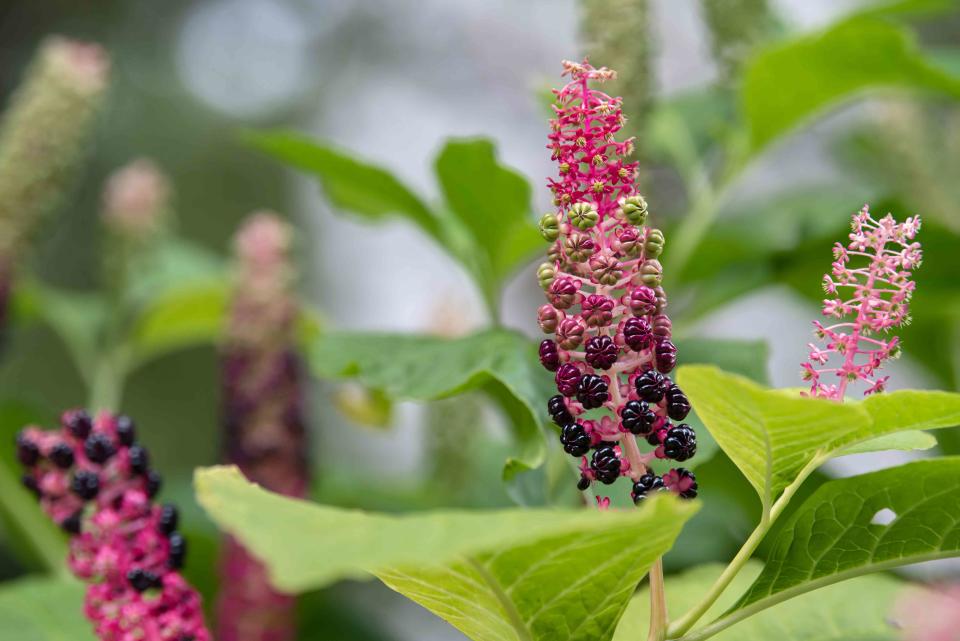
The Spruce / Evgeniya Vlasova
Reviewed by Amanda Rose Newton
Pokeweed is considered an invasive species when growing outside of the eastern half of North America, to which it is native. It is an easy plant to identify, especially when its berries ripen to their characteristic purple color in late summer. Even earlier in the season, its immense size compared to other perennial weeds is helpful in identification. If you do not have concerns about its invasiveness, it may still be wise to get rid of pokeweed if children or pets will be in the yard: It is toxic to both of them.
Warning
The berries, leaves, and roots of pokeweed are all toxic. Although the young leaves have traditionally been cooked and eaten (thus the common name, "pokesalad"), only the experienced should try this; leaves not properly prepared are toxic. In addition to being toxic to humans, pokeweed is also toxic to pets.
While pokeweed does die back to ground level every winter, it is a difficult weed to get rid of. Winter kills off only the above-ground growth. The plant remains viable at root level and comes back every spring. Pokeweed can be effectively removed by manually digging up the plant and its taproot or by using an herbicide containing glyphosate. Manually removing the plant is the safest and most eco-friendly method but herbicides can be used carefully if needed. Find out more about what you have to do to kill pokeweed successfully.
Common Names | Pokeweed, common poke, pokesalad (poke sallet), pokeberry, American pokeweed, inkberry, pigeonberry, scoke |
Botanical Name | Phytolacca americana |
Plant Type | Herbaceous perennial (considered a shrub by some because of its size) |
Mature Size | 2-10 ft. tall, 2-3 ft. wide |
Soil type | Moist, fertile loam |
Bloom Time | Early summer |
Flower color | Greenish-white |
Hardiness Zones | 4-8 (USDA) |
Native Area | Eastern North America from Ontario to Florida, midwestern United States |
Toxicity | Toxic to humans and animals |
How to Identify Pokeweed
Except for its racemes of ripened berries, which dangle down toward the ground, pokeweed has an upright habit. These racemes can be quite large (up to 8 inches long). The berries start out green but mature to a striking dark purple. Pokeweed stands taller than most weeds, at 2 to 10 feet. When all of these characteristics are taken together, they make for a showy plant.
Pokeweed's height is usually greater than its width. It has numerous stems. These stems are smooth, thick, and mature to a purplish color. The green, egg-shaped leaves are alternate, simple, have entire leaf margins, and emit a foul odor if bruised. The unremarkable flowers are greenish-white and begin blooming in early summer.
Pokeweed Invasiveness
Warning
Pokeweed is currently on the invasive species list of only one state (California), but its presence has been reported in other western U.S. states. It can be considered potentially invasive throughout much of the western United States, especially the Pacific Northwest, where the moist climate is conducive to the spread of the plant. It is also listed as an invasive plant in Japan.
Pokeweed is most closely associated with the American southeast but occurs as a native throughout the eastern half of North America (including the Midwest). It can also be found outside of its native range on the West Coast and in Arizona and New Mexico. Its range cuts across many USDA hardiness zones (from 3 to 10).
While pokeweed thrives in fertile soil that remains evenly moist, it is tolerant of a wide range of conditions. It survives in full sun or partial sun and soil of average fertility; it even tolerates some drought. The main thing it needs is good drainage. Because of its flexibility, it can be found not only in the wild but also in people's backyards. It occurs in fields and pastures, but also in open woods and thickets. It will grow almost anywhere the ground has been disturbed, including along roads.
Pokeweed displaces native species when it grows outside its native range—the very definition of invasive. Pokeweed spreads by seed. It spreads quickly by seed due to the impact of wild birds feeding on it. Birds, immune to the toxin in pokeweed, eat the berries and spread the seed as it passes through their systems.
Pokeweed Toxicity
Avoid planting pokeweed in your yard (and do not allow pokeweed that has spread on its own to your property to remain) if children will be playing in your yard and/or dogs or cats will be let loose on your property. The toxicity of the plant makes it potentially undesirable even in cases where invasiveness is not an issue.
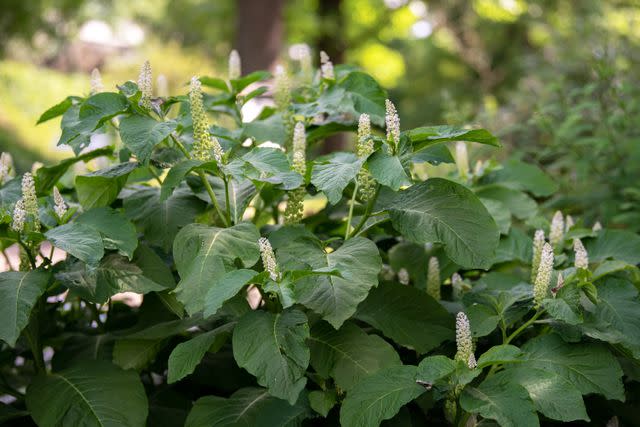
The Spruce / Evgeniya Vlasova
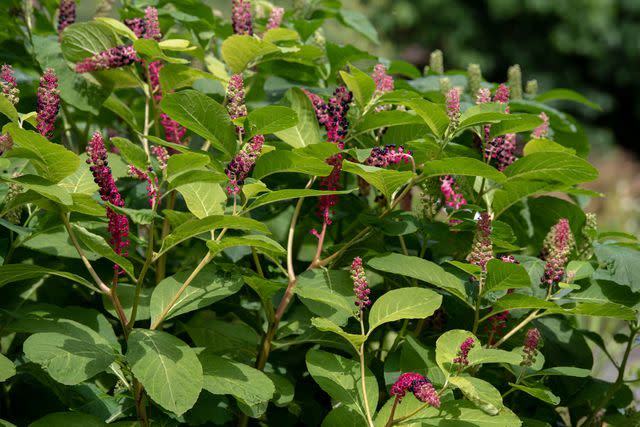
The Spruce / Evgeniya Vlasova
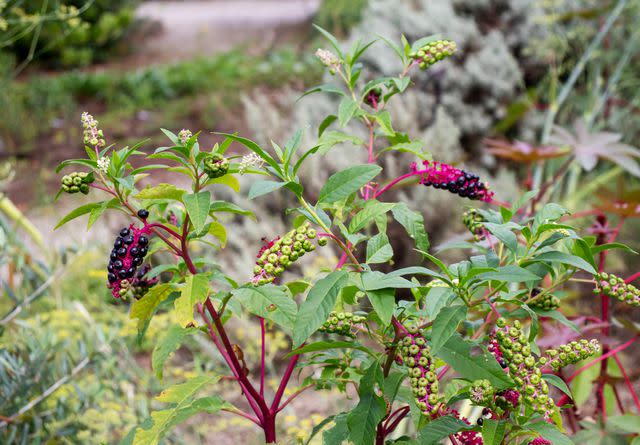
photohampster/Getty Images
Pokeweed develops purplish stems as it matures.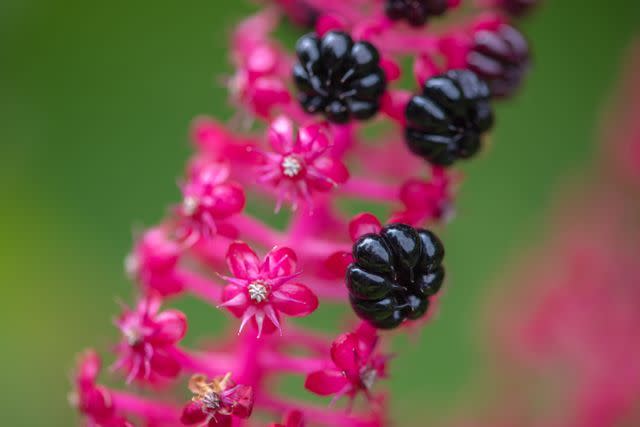
The Spruce / Evgeniya Vlasova
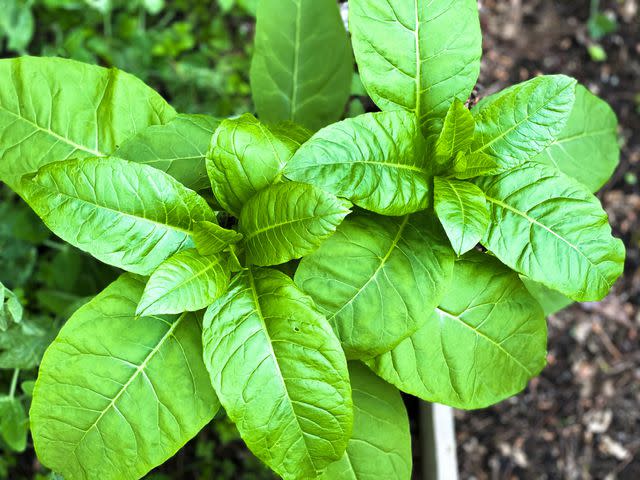
Catherine McQueen / Getty Images
Pokeweed is mainly green when young.How to Get Rid of Pokeweed
Getting rid of young pokeweed is much easier than removing established pokeweed. You should manually remove young plants with softwood stems, but larger mature plants have harder trunks that can be difficult to remove. In some cases, herbicides are necessary to thoroughly kill the plant underground if it's mature.
Pokeweed is deceptively tenacious because of its herbaceous nature. What we do not realize is the reservoir of strength it holds underground. It has a thick, large taproot from which it emerges each spring. Because of this taproot, hand-pulling is not an effective method of removal: The part of the plant that you are pulling tends to break off from the taproot, from which re-sprouting will occur. If you still wish to stick with manual removal, dig the plant out (roots and all) with a shovel.
Manual Removal
Digging the plant out will be the preferred method for those who are in good health and who garden organically. However, some people do not mind using chemical herbicides. Others may not be in good enough health for digging (especially if the weed is growing in rocky and/or compacted soil). If you fall into either of these camps, you may prefer to remove pokeweed by using a weed killer.
Herbicides
It is easy to get rid of invasive plants like pokeweed permanently by spraying the leaves with a glyphosate-based solution. It is not a solution without issues, though. Glyphosate is a non-selective herbicide. That means it harms almost all vegetation that it comes into contact with. Be careful not to get any on the plants that you want to keep.
Possible health issues regarding the use of glyphosate make it imperative that you protect yourself while spraying by wearing gloves, goggles, long pants, and a long-sleeved shirt.
Timing is important. Do not spray glyphosate solutions on a windy day: You want to be able to hit your target (the leaves) and nothing else. Spray pokeweed when it is actively growing (summer or early fall). Avoid spraying when rain is in the forecast since the rain would wash the herbicide off the leaves prematurely. Glyphosate works best when vegetation has been coated with it and then strong sunshine strikes that vegetation for several hours.
Read Next: The 10 Best Weed Killers of 2023
Frequently Asked Questions
Is pokeweed hard to get rid of?
Younger pokeweed with small roots can be easier to get rid of than more established plants with spreading roots.
Can I touch pokeweed with my hands?
Always wear protective gloves when touching pokeweed.
Does pokeweed grow back?
It will grow back if it is left untouched after pulling the larger plants but herbicides, like glyphosate, can kill the taproot. You may have to spray the pokeweed more than once to remove it permanently.
Read the original article on The Spruce.

